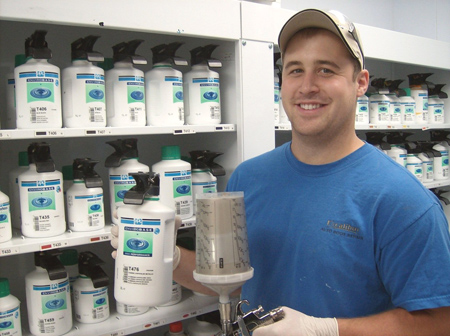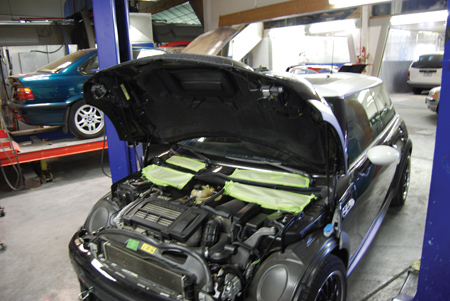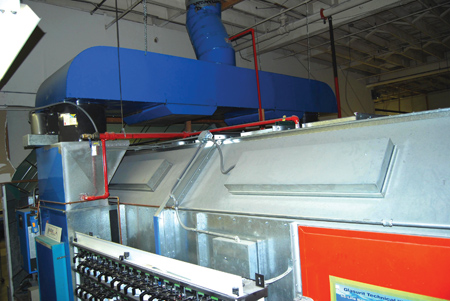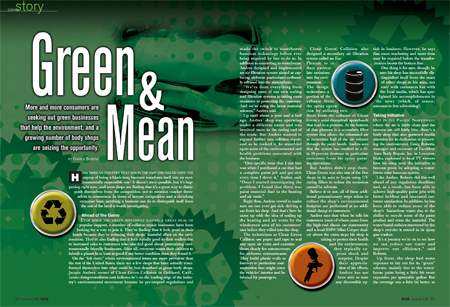


 How does an industry that has in the past struggled with the stigma of being a black-lung business transform itself into an environmentally responsible one? It doesn’t seem possible, but it’s happening right now, and most shops are finding that it’s a great way to distinguish themselves from the competition, not to mention market themselves to consumers. In times of intense competition and a shrinking customer base, anything a business can do to distinguish itself from the rest of the herd is worth investigating.
How does an industry that has in the past struggled with the stigma of being a black-lung business transform itself into an environmentally responsible one? It doesn’t seem possible, but it’s happening right now, and most shops are finding that it’s a great way to distinguish themselves from the competition, not to mention market themselves to consumers. In times of intense competition and a shrinking customer base, anything a business can do to distinguish itself from the rest of the herd is worth investigating.
Ahead of the Game
Ever since the green movement gained a great deal of popular support, a number of collision repair businesses have been looking for a way to join it. They’re finding that it feels good in their heads because they’re reducing their shops’ harmful effect on the environment. They’re also finding that it feels equally good in their wallets due to increased sales to customers who also feel good about patronizing environmentally friendly businesses. After all, everyone wants their children to inherit a planet in at least as good if not better condition than they found it.
On the “left coast,” where environmental issues are more prevalent than the rest of the United States, there are a few shops that have actually transformed themselves into what could be best described as green body shops. Jacque Andres, owner of Clean Green Collision in Oakland, Calif., (www.cleangreencollision.com) believes he’s on the leading edge of the industry’s environmental movement because he pre-empted regulations and made the switch to waterborne basecoat technology before ever being required by law to do so. In addition to converting to waterborne, Andres designed and implemented an air filtration system aimed at capturing airborne particulates ordinarily released into the atmosphere.
“We’ve done everything from designing some of our own tooling and filtration systems to taking extra measures to protecting the customer. And we’re using the latest material sciences,” Andres said.
Up until about a year and a half ago, Andres’ shop was operating under a different name and was involved more in the racing end of the trade. But Andres wanted to expand further into collision repair, and as he looked it, he stumbled upon some of the environmental and health problems associated with the business.
“One specific issue that I ran into was when I purchased a car that had a complete paint job and got sick every time I drove it,” Andres said. “Once I started investigating the problem, I found that there was paint material dust in the heating and air vents.”
Right then, Andres vowed to make sure no one ever got sick driving a car from his shop. And that’s how he came up with the idea of sealing up the heating and air vents by the windscreen area of his customers’ cars before they rolled into the shop.
The technicians at Clean Green Collision use paper and tape to seal any open air vents and examine doors closely for entranceways for airborne contaminants. They build plastic walls as barriers to particulate contamination that might enter the vehicles’ interior and be inhaled by passengers.
Clean Green Collision also designed a secondary air filtration system called an Eco Plenum to re-duce particulate emissions into the environment. The design recirculates a portion of the exhaust from the spray operation by utilizing two ducts from the exhaust of Clean Green’s semi-downdraft spraybooth that lead to a plenum. At the bottom of that plenum is a secondary filter system that allows the exhausted air to recirculate half of the air volume through the paint booth. Andres says that the system has resulted in a 25- to 30-percent decrease in particulate emissions from his spray painting operations.
But Andres didn’t stop there. Clean Green was also one of the first shops in its area to begin using UV curing fillers to reduce the emissions caused by solvents.
Believe it or not, all of these additional precautionary steps taken to reduce the shop’s environmental footprint are performed at no additional charge to customers.
Andres says that when he tells his customers (most of whom come from the high-end classic car community and a local BMW/Mini Cooper dealer) about the extra steps his shop is taking to protect their health and the environment, they typically ex-press shock and surprise. Despite their appreciation of his efforts, Andres has not been able to note any discernible up-tick in business. However, he says that more marketing and more time may be required before the transformation boosts the bottom line.
One thing is for sure, though: he says his shop has successfully distinguished itself from the mass of other shops in his area, not only with customers but with the local media, which has spotlighted his accomplishments in the news (which, of course, amounts to free advertising!).
Taking Initiative
Out in the Pacific Northwest where the air is fairly clean and the streams are still fairly blue, there’s a body shop that also garnered media attention for its dedication to preserving the environment. Craig Roberts, manager and co-owner of Excalibur Auto Body Repair, Inc. in Lewiston, Idaho, explained to local TV viewers how his shop took the initiative to become green by adopting a waterborne color basecoat system.
Like Andres, Roberts did this well ahead of any regulation deadlines and, as a result, has been able to achieve high-quality paint jobs with better holdout and increased customer satisfaction. In addition, he has been able to reduce some of the shop’s hazardous waste due to the ability to recycle some of the paint product and reuse the material. The water-based reducer recovered by the shop’s recycler is reused in its spray gun washer.
“It’s a journey we’re on to see how we can reduce our waste and improve our efficiency,” said Roberts.
Up front, the shop had some expenses to lay out for its “green” scheme, mainly due to the waterborne paint being a little bit more expensive per sprayable gallon. But the coverage was a little bit better, so Roberts feels that everything has averaged out.
In terms of the shop’s productivity, Roberts reported some improvement in the paint department.
“Overall, we’ve seen our productivity increase,” Roberts said. “We have enough airflow in our paint booth, so we seldom use the hand-held driers. Once we caught up to the learning curve, we actually had more throughput.”
Roberts admitted that Lewiston does have a drier climate than, say, the east coast states, which aids the waterborne drying process. In the mid-summer months, the humidity in Lewiston can drop as low as 40 percent. But he primarily attributes the drying of the waterborne paint to the airflow of his downdraft spraybooth, in tandem with hand-held air driers that help to hit hard-to-reach spots on a vehicle’s surface.
Regarding the quality of the shop’s finishes, Roberts reports some positive results in terms of color match and durability, so the costs to his operation as a result of the transition have been negligible. Excalibur actually installed the waterborne system in 2003 on a limited basis, which allowed the paint department to become acclimated to the system over time. For instance, Roberts said they had to change clear coats to a slower drying system. But given that five years have passed and no significant number of comebacks or paint-related failures have appeared on his doorstep, Roberts and his crew have grown very confident in the system.
Roberts believes the boost to his shop’s image as the result of greening its operation has happened a lot quicker than the learning curve for waterborne.
“It has been pretty big,” said Roberts. “There are a lot of people who are concerned about the environment, and for good reasons. We want to play our part in it, and customers seem to be appreciative of what we have done.”
Still, some shops have experienced concern from consumers about how the waterborne product will hold up in the elements and thus have had to educate them about its properties. In Europe, once customers were told that OEMs use waterborne basecoats in their plants and many collision repair facilities also use them, they generally accepted the technology and welcomed its use on their cars and trucks.
Roberts says Excalibur is the only shop in its market that is currently using waterborne basecoat technology and may be the first in the state to convert 100 percent to waterborne.
For Excalibur’s efforts, it was presented with the Pollution Prevention Partner award from the state’s Department of Environmental Quality for being a champion in pollution prevention. And Excalibur made sure all local media outlets and all of its customers were made aware of the recognition. After all, why wouldn’t a shop that has gone through the expense and hardship of converting to green not trumpet its success?
Recognition Rules
Going green also paid off with awards and media for Kadel’s Auto Collision Repair Service in Salem, Ore. The shop, which is the largest collision repairer in the Pacific Northwest with 13 locations and the tenth-largest privately held collision repair center in the U.S., was featured on an Oregon television newscast after winning an Eco-Logical Business award from the Portland Pollution Prevention Outreach Team (P2O). The award doesn’t mean the shop produces zero waste but only that it’s efficient in its management and disposal of hazardous materials.
Kerry Glass, marketing manager for Kadel’s, says most business owners would be surprised how many people ask, “Are you a green company?” He says that this clearly demonstrates consumers’ desire to give their hard-earned dollars only to companies that care about the environment.
Like many shops, Kadel’s recycles its paint waste. The solid is a waste residue from that process which is given to a waste hauler. Waste antifreeze and oil are reclaimed, and scrap metal is collected by recyclers, as is the shop’s paper waste products.
Unlike many shops, however, Kadel’s has received recognition for many other innovative steps it has taken to protect the environment that that most other U.S. shops have adopted. That recognition makes a difference in the public’s perception of its enterprise, which is sorely needed for an industry that has traditionally been regarded as more of an offender than a defender of the environment.
Evolution Underway
While many shops have been required to handle hazmats responsibly, most wouldn’t dream of behaving the way shops did 40 years ago. Back then, the mindset was very different in that waste was discarded without a care. And the results of those actions were inconsequential…at least as far as we knew. Much has changed in that respect.
Today, auto salvage operations are getting credit for being one of the most effective recyclers of parts and commodities, such as steel and aluminum. This perception, however, has only been created over the last decade or so, but has given that industry a new image – one 180 degrees from its former self.
Methods of reducing a carbon footprint are readily available to body shops today. Unnecessary waste simply doesn’t make good environmental sense, nor does it make good business sense. As an industry, we’ve come to understand that what we’ve been doing as a profession doesn’t always have a good ecological impact. There are, however, a growing number of alternatives available for us to become stewards of the environment.
Writer Charlie Barone has been working in and around the body shop business for the past 35 years, having owned and managed several collision repair shops. He’s an ASE Master Certified technician and a licensed damage appraiser, and has been writing technical, management and opinion pieces since 1993. Barone can be reached via e-mail at [email protected].













